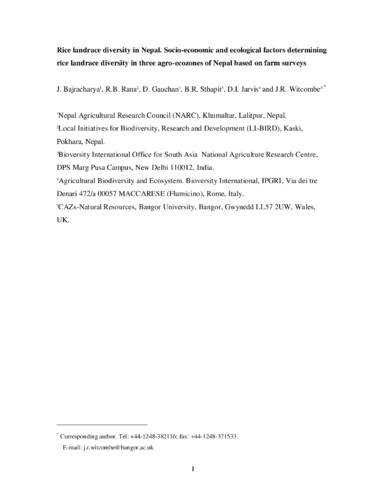Rice landrace diversity in Nepal. Socio-economic and ecological factors determining rice landrace diversity in three agro-ecozones of Nepal based on farm surveys
Abstract
In Nepal, in traditional rice farming systems many diverse landraces are grown in all of the rice agro-ecosystems from low to high altitude. Three case study sites were selected to represent the major rice agro-ecozones: Bara (100–150 m) for the low-altitude terai (plain); Kaski (700–1,206 m) for the mid-hill zone; and Jumla (2,200–3,000 m) for the high-hill zone. The diversity in rice varieties was compared in these three sites and nine survey villages in a series of surveys conducted in 1998, 1999 and 2006. The level and distribution of diversity on farm varied with the physical and socio-economic settings of the farming communities. The mid-hill site (Kaski) had the highest rice landrace diversity. This was adapted to the diverse agro-ecosystems found there and there was equal diversity in Kule khet (irrigated lands by seasonal canals) and Sim khet (marshy wet land). The next most diverse system was Nicha khet (irrigated lowlands) in Bara, the low-altitude site. The high-hill site (Jumla) had the lowest rice diversity. Across all sites many of the landraces were rarely grown and then only in small areas, reflecting the specialized uses to which they were put. At all sites the most common single landrace occupied less than half of the rice area. Resource-rich farmers were the more important custodians of on-farm rice varietal diversity across the sites. There was more rice diversity in favourable environments than in less favourable ones. This was true whether diversity was measured across sites or across rice domains within sites.

